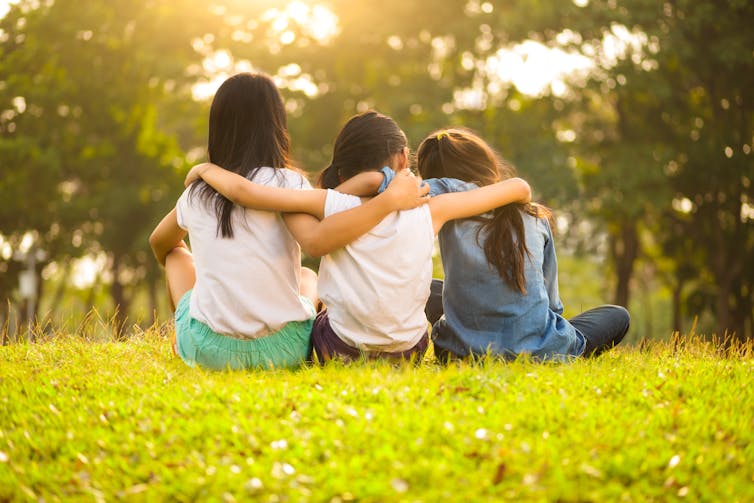Green space around primary schools may improve students' academic performance
- Written by Alison Carver, Senior Research Fellow, Behaviour Environment and Cognition Program, Mary MacKillop Institute for Health Research, Australian Catholic University
Greenery around primary schools may improve students’ academic performance, while traffic pollution may be detrimental, our study[1] shows.
With increasing urbanisation in Australia and globally, consideration needs to be given to the location of schools. Children need to grow and learn in environments that promote their physical health, as well as their cognitive development and academic learning.
Our research mapped greenery and traffic exposure around 851 primary schools across greater Melbourne.
We examined how greenery and traffic-related air pollution were associated with the average 2018 NAPLAN scores in years 3 and 5. The scores were in five domains: reading, writing, spelling, grammar, punctuation and numeracy.
People tend to see green leafy suburbs as more wealthy, and socioeconomic status is a significant predictor of academic scores. So to ensure we were looking at the effects of the greenery itself, we compared schools in the same socioeconomic bracket. We found more greenery was associated with better NAPLAN scores. Meanwhile, higher exposure to traffic-related pollution was associated with poorer scores.
The importance of urban greenery
A growing body of evidence shows access to green space — which includes parks, trees, shrubs and grass — is linked to[2] children’s healthy development.
We know greenery in urban areas may boost mental health[3] among older adults and can offset[4] traffic emissions.
Research conducted internationally suggests greenness surrounding schools can lead to better cognitive development[5] in primary school-aged children. But there is still debate[6] over whether greenery around schools can boost academic performance.
 Green space is linked to healthy development in children.
Shutterstock[7]
Green space is linked to healthy development in children.
Shutterstock[7]
Exposure to traffic-related air pollution at school, where children spend much of their waking hours, has been associated with poorer performance[8] in tests of brain health and development. Air pollution may be more detrimental to the health[9] of children compared with adults, due to children’s physiology and rapid growth.
We wanted to investigate if greenery and traffic pollution have clear links with academic performance, an indicator of cognitive development.
Children perform better with more greenery
We measured the amount of greenery in the school grounds, and then the traffic pollution and greenery around the school grounds within distances of 100m, 300m, 1,000m and 2,000m.
We found school-level academic performance in reading, numeracy, grammar and punctuation was better on average for schools located in areas with more greenery.
Our statistical modelling included data on socioeconomic levels of the area as well as variations in schools, such as parental occupation and proportion of Indigenous students.
Read more: People's odds of loneliness could fall by up to half if cities hit 30% green space targets[10]
We compared the NAPLAN scores of similar socioeconomic-status schools and found higher scores in greener areas. For example, when comparing schools with the highest and lowest levels of green within 300 m, we found statistically significant differences of an average 20 points in reading scores for year 5.
Poorer performance was associated with higher levels of traffic-related air pollution surrounding schools. Reading scores in year 5 were around 16 points lower, on average, in schools with the highest levels of traffic-related air pollution within 300m of schools, compared with those with lowest levels.
 There is a link between more green space around schools and higher academic scores.
Shutterstock[11]
There is a link between more green space around schools and higher academic scores.
Shutterstock[11]
The specifics of the NAPLAN scores aren’t as important as the associations we found with greenery and traffic pollution. Our findings show preliminary evidence that greener environments with low traffic levels around primary schools may promote children’s academic performance.
Read more: Higher-density cities need greening to stay healthy and liveable[12]
Our exploratory study is the first of its kind in Melbourne, a metropolis with projected growth and plans[13] for future school developments and traffic infrastructure.
How can greenery help?
Greenery can help reduce air pollution in several ways[14] including filtering the air through plant surfaces and foliage.
But other factors (not examined in our study) that may play a role in the association between greenery and academic performance are related to the type and location of greenery.
Better performance among children in greener areas could be due to attention restoration, stress reduction or reducing harmful environmental exposures (such as noise from traffic and air pollution).
Town and school planners, as well as educators, should consider where schools are located and how their surrounding environments may be improved to promote childhood learning and health.
Additional steps to reduce traffic levels around schools should be encouraged where possible, as well as active transport and use of public transport to reduce the number of vehicles on the roads.
References
- ^ our study (www.sciencedirect.com)
- ^ is linked to (www.pnas.org)
- ^ boost mental health (jamanetwork.com)
- ^ and can offset (pubmed.ncbi.nlm.nih.gov)
- ^ better cognitive development (www.pnas.org)
- ^ still debate (pubmed.ncbi.nlm.nih.gov)
- ^ Shutterstock (www.shutterstock.com)
- ^ associated with poorer performance (pubmed.ncbi.nlm.nih.gov)
- ^ more detrimental to the health (pubmed.ncbi.nlm.nih.gov)
- ^ People's odds of loneliness could fall by up to half if cities hit 30% green space targets (theconversation.com)
- ^ Shutterstock (www.shutterstock.com)
- ^ Higher-density cities need greening to stay healthy and liveable (theconversation.com)
- ^ projected growth and plans (www.planning.vic.gov.au)
- ^ help reduce air pollution in several ways (pubmed.ncbi.nlm.nih.gov)

















